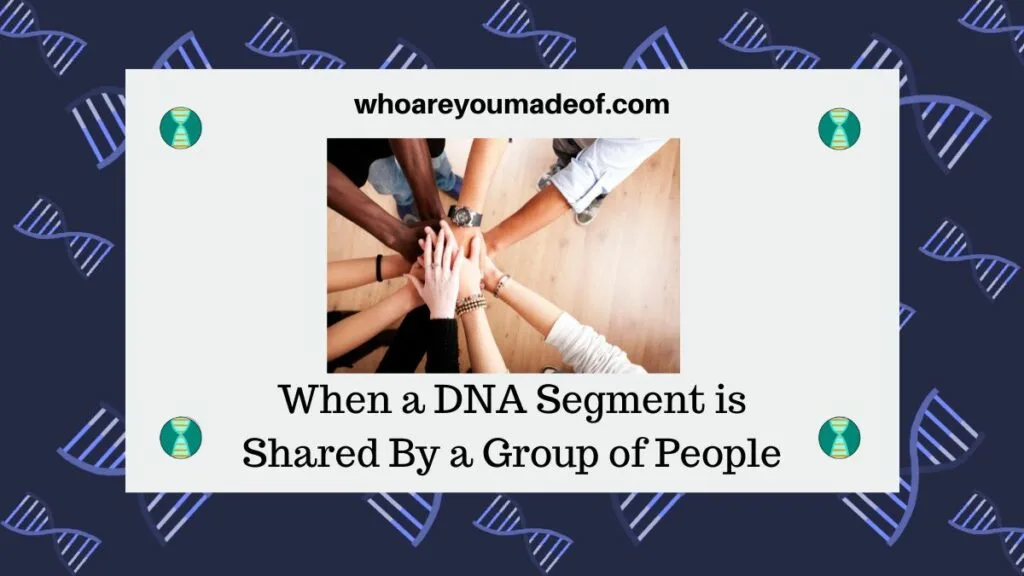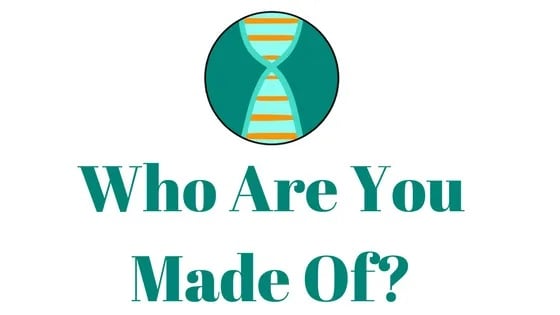Do you have a situation where multiple people on your DNA match list share the same DNA segment with you? In this post, learn what this means, and what you can learn from this group of matches.

There is so much that we can learn from our DNA matches. Understanding what it means when more than one person on our match lists shares the same segment is a good first step to take your research to the next level.
Your DNA match list is filled with many different groups of people who all share identical DNA segments with you and others on your list. Towards the end of this post, you will learn a few different ways that you can find your own groups of people who all share the same segment of DNA with you.
What does it mean when a group of people share the same DNA segment?
A group of people who all have an identical DNA segment overlapping the same locations on the same chromosome may share a common ancestor. If the most recent common ancestor shared between the group of DNA matches can be identified, it may then be determined that the DNA segment was inherited by all group members from that common ancestor.
If you are able to find the common ancestor shared with a group of people that share the same DNA match with you, you have done a technique called “triangulation”. Triangulation is when we use a DNA segment shared between two or more people to locate a common ancestor.
| Chromosome | Start | End | |
| Match 1 | 20 | 29,558,463 | 62,189,093 |
| Match 2 | 20 | 29,833,609 | 50,644,512 |
| Match 3 | 20 | 29,833,609 | 51,514,621 |
The data for the table above includes data from three of my dad’s DNA matches. These three matches share an identical segment on Chromosome 20, and if you look at the start and end locations of the identical segments, you will note that these segments have a large overlap.
Each of the matches are related to my dad at a different relationship distance, which is once reason that we see that the segments have slightly different lengths. The size of the segment shared with Match 3 is 26.8 cMs (centimorgans).
We can use size of the shared segments to estimate how far back our common ancestor might be. The longest segment shared with a DNA match is typically the most useful for this estimation.
Does the identical segment mean everyone in the group is related to each other, too?
It is possible that the people in your group of people that share the same segment with you are related on different sides of your family. Before you begin trying to find your shared ancestor, it is important to make sure that all of the matches in the group are all on either your paternal or maternal side.
We inherit one copy of each chromosome from each of our parents. When we share an identical segment with a DNA match, it is important to know which copy of the chromosome (i.e. mom or dad’s copy) the segment is located.
The best way to do this is through a process called “phasing” where you compare your DNA matches to your parents’ DNA and split them into groups. This process, which you can do on Gedmatch, also can eliminate most false DNA segments.
Ancestry also automatically “phases” DNA matches into Parent 1 and Parent 2 groups using their SideView technology. We will not be able to see that the parent shares the same exact DNA segment with the match on Ancestry, but we can see whether each parent shows up as a match for each person in question, which can provide us with a clue as to whether the match is paternal or maternal.
Most DNA testing sites don’t have a tool for automatically phasing our matches, which means that we have to resort to other methods to try to make sure that each match is on the same side of our family. We might be able to compare our match to one parent, a close relative on each side, or use family tree data to come to an informed conclusion.
Shared DNA segments, or matches that you share in common with each person in the group, can also help with this.
False segments are possible even when shared by a group
Even when an identical DNA segment is shared among a group of people, it is important to know that false segments are still possible. Even though the smallest DNA segments are more likely to be false, we can still occasionally see larger false segments.
In the example that I shared above, you saw that both Match 2 and 3 share close to 26 cMs. At this size, the segment has a high probability of being a legitimate segment inherited by a shared ancestor, but it is still not impossible for it to be a false segment.
When you are examining a segment shared by a group of matches and one person’s family tree doesn’t seem to fit into the rest, you might consider the option that the DNA segment is an identical-by-state (IBS) false match. Clues such as the size of the segment and whether you share multiple segments with the match can help you figure this out.
How to find segments shared with multiple DNA matches
If you have never noticed before that you share the same DNA segment with more than one person, you might wonder how you can find examples of this in your own DNA results. Once you learn how to find this data, you will realize how often this happens.
Anyone who has done a DNA test with MyHeritage, Family Tree DNA, or 23andMe, has access to “chromosome level data” via the chromosome browsers available on each site. On the chromosome browser, you can see the location and size of each identical segment that you share with your DNA match.
You can search for segments shared with multiple matches manually, or you can use an automatic tool such as the AutoClusters tool on MyHeritage to group matches into likely clusters.
Alternatively, you could use the Tier One tool called “Matching Segment Search” on Gedmatch. This paid tool can help you quickly find segments that you share with multiple DNA matches, as long as those DNA matches have also uploaded their DNA to Gedmatch.
You can use a spreadsheet to make a note of overlapping segments, or you can use a site like DNA Painter to help you keep track of these segments.
Conclusion
I hope that this post has helped you understand more about what it means when a group of several DNA matches all have an identical DNA segment at the same location on the chromosome, and what this information can really help you learn about your shared ancestry.
If you have any questions about something that you read in this post, or if you would like to share your own story about how you were able to figure out how a group of your matches are related, please join in the discussion below.
Thanks for reading today!

Laurie
Tuesday 6th of February 2024
Thank you so much for explaining this so clearly. I've been working with a group of eight matches from FTDNA who all share an almost identical segment with me on chromosome four. These segments range between 22 and 28 cms. I did a segment search on GEDmatch for this segment using my phased maternal kit and found an additional 25 matches who share this same segment with me. I am wondering if the large number of people sharing this segment might indicate that these matches are not identical by descent? How many is too many? I should mention that I come from a strongly endogamous population. Thank you!
Marge
Sunday 12th of November 2023
Thank you for the interesting information you share every week.
Mercedes
Monday 13th of November 2023
Thank you so much your kind words!